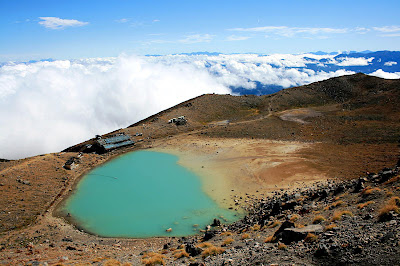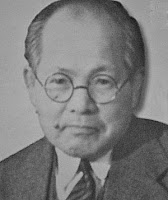Unwittingly, we behaved just as Fukada Kyūya said we would. Big-booted, ice-axe-wielding alpinists feel out of place here, wrote the Hyakumeizan author back in the 1960s. They shun the peak as too popular and avoid it. The few mountaineers who do come here tend to avoid the summer season.

And so we ski-climbed Ontake on a crisp, clear winter day, laying our zig-zag tracks up a flank of hard-frozen snow. On the summit plateau, at 3,000 metres, it was the steam-jets pluming from the new crater that captured our attention. Not being greatly into mountain history, we didn’t give much thought to the statues and monuments, half-buried in snowdrifts, that marked out this ancient volcano as one of Japan’s most sacred summits.

Besides, the harrying breeze made it too cold to hang about. After posing for photos at the summit shrine, we snapped our big boots into our Silvretta 404 bindings and pointed the skis downhill. After that, there was no reason to revisit Ontake. Until, that is, the other day when an e-mail came in from Ted, a fellow Japan blogger and aficionado of the old Nakasendō road:
On one of my walks, writes Ted, I came across a small Ontake shrine between the towns of Nakatsugawa and Ochiai, both in Gifu. There was a small group of people there, in the midst of their cups, the prayers now done. I asked them what was going on, and they told me that it was a ceremony in honor of Kakumei Reijin (覚明霊神), who 'opened' Mt. Ontake. Try as I might, I can't seem to find the 'human' name for this deity, who this person actually was. Do you have any idea?
Well, it turns out that Kakumei Reijin isn’t mentioned even in Nihon Hyakumeizan, Japan’s most famous mountain book. But a quick look at Google and some other references hinted at a fascinating story.

The Buddhist name “Kakumei”(覚明) is written with different characters from the Japanese word for “revolution”, which is pronounced the same way. Yet monk Kakumei (1718-1786) was indeed a revolutionary. He challenged the adepts and shrine authorities who held Ontake in their exclusive grasp, and opened the mountain to ordinary people. Unlike many a revolution, however, the movement he started has endured to this very day.
When Kakumei was born at Kasugai in Owari province (today’s Aichi Prefecture), the son of a farmer, Ontake had already been revered for centuries. Indeed, its very name means “Sacred Mountain”. Records from the Muromachi period (1392–1573) show that the austerities practised there by mountain mystics resembled those of Ōmine and Kumano.
Kakumei also came to Ontake as a hermit or yamabushi – the word means ‘one who hides himself in the mountains’. But he seems to have soon run afoul of the local shrine authorities with his revolutionary ideas of improving the mountain paths, so that ordinary people could climb the mountain. And letting them do so without undergoing the traditional seventy-five or one hundred days of severe purification rituals.

In the fifth year of Tenmei (1785), Kakumei took matters into his own hands. He climbed the mountain after purifying himself only with a “water austerity”, probably by standing under a waterfall at the mountain’s foot. This was by itself a challenge to the religious establishment.

The following summer, he made another ascent. Struggling with the burden of his sixty-eight years and frail as an autumn leaf from years of fasting, he made his way up to Ni-no-ike (above), a crater lake far above the clouds. And there, as the wind chased ripples over the cobalt waters, he gave up his spirit.
 Ontake now had its martyr; next a proselytiser was needed. That role was fulfilled by monk Fukan (1731-1801), who came to the mountain in 1792. Fukan (right) pioneered a new way up the mountain – one that was more convenient for pilgrims coming from the fast-growing city of Edo – and founded hundreds of congregations or kō (講) all over the Kantō region. Known as Mitakekyō or Ontakekyō, the resulting movement gained official recognition as a sect within Shintō in 1882.
Ontake now had its martyr; next a proselytiser was needed. That role was fulfilled by monk Fukan (1731-1801), who came to the mountain in 1792. Fukan (right) pioneered a new way up the mountain – one that was more convenient for pilgrims coming from the fast-growing city of Edo – and founded hundreds of congregations or kō (講) all over the Kantō region. Known as Mitakekyō or Ontakekyō, the resulting movement gained official recognition as a sect within Shintō in 1882.Thus far, the story has close parallels with that of the Fuji-kō, the congregations whose worship centred on Japan’s highest mountain. Mt Fuji too had its martyr, in the person of Jikigyō (1670-1733), who fasted to death in a rocky cell near the mountain’s sixth station. (The shrine authorities kept him away from the summit, for fear that his death would ritually pollute this sacred ground.) And Jikigyō’s self-sacrifice greatly increased the popularity and prestige of the congregations that worshipped Mt Fuji.
In time, both Ontakekyō and the Fuji-kō won so many converts that the feudal authorities started to worry about the sects as potential sources of unrest. (The parallel with the Chinese Communist Party’s current nervousness about Falun Gong is striking.) Inheriting these suspicions, the Meiji government coerced both movements (or large sections of them) into becoming approved sects within state-controlled Shintō.
It was at this point that the fortunes of the two mountain religions started to diverge. For the Fuji-kō, official recognition seems to mark the start of a long decline. In contrast, Ontakekyō has held up against the secularising trend of the modern age with surprising resilience. By 1938, for example, the two officially recognised Fuji sects reported about one million adherents between them. Ontakekyō had twice as many.
The extraordinary durability of the Ontake faith was noted by Fukada Kyūya in Nihon Hyakumeizan, which was published in 1964:
In the past, holy mountains were legion, among them Fuji, Chōkai, Tateyama, and Ishizuchi to name but a few. Yet their sacred aura has dissipated in the light of modern mountaineering. Ontake alone retains its bands of pilgrims, their rituals and their customs. If you climb the mountain on a summer's day by its front route from Ōtaki and Kurosawa, the white robes of the faithful, among them both children and greybeards, still limn out the path ahead. These people are not climbing the mountain for sport. I know the owner of a teahouse who would otherwise take no interest in mountains, yet never fails to make her annual pilgrimage to the top of Ontake.

Even today, reports Naoko Kobayashi, a researcher at Nagoya University, Ontake and its “great gods” are worshipped by an estimated 800,000 believers and more than 1,000 congregations. Among the reasons for the cult’s success, she suggests, is the strong belief in its reijin. This is the title given to deceased devotees of Ontake. Reijin are enshrined in reijin-hi, small stone monuments set up in groves at various places on the mountain.
Reijin-hi become the yori-shiro (the spirit abode) of a deceased Ontake adherent. And living relatives can use them as a means of communicating with the departed. This is the purpose of a shamanistic ritual known as the oza in which a practitioner (maeza) encourages the departed spirit to possess a medium (known as the nakaza). Graphic descriptions of such séances can be found in books by both Walter Weston and Carmen Blacker (see references).
While doing her fieldwork, Kobayashi met a woman who had just lost her brother:
An Ontake ascetic acted as the maeza. After the reijin possessed the nakaza, he stated that her brother was fine and in training near the Ontake Ogami in the next world. When the woman heard this, she started to cry. She said that she was relieved to know that her brother was fine in the other world.
The worship of reijin serves to tie the devotees to the Ontake faith. In this way, the reijin facilitates a form of ancestor worship, one of the most ancient elements in Japan’s culture. Moreover, concludes Kobayashi, “the chain of successors, from the believers to the reijin, perpetuates Ontake belief. As long as Ontake believers continue to worship the reijin, Ontake belief will continue.”
References
Nihon Hyakumeizan in the forthcoming translation as One Hundred Mountains of Japan
Naoko Kobayashi, Research report: The vital role of reijin worship in Ontake belief in SOAS Centre for the Study of Japanese Religions newsletter, January 2005 issue
D C Holtom, The National Faith of Japan: A Study in Modern Shintō, 1938
Walter Weston, Mountaineering and Exploration in the Japanese Alps
Carmen Blacker, The Catalpa Bow
All above images of Ontake after the first two are from Wikipedia (Japan)







